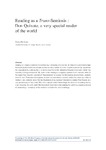Mostrar o rexistro simple do ítem
Reading as a Trans-Semiosis: Don Quixote, a very special reader of the world
| dc.contributor.author | Choi, Yog Ho | es_ES |
| dc.date.accessioned | 2014-10-02T12:31:25Z | |
| dc.date.available | 2014-10-02T12:31:25Z | |
| dc.date.issued | 2012 | es_ES |
| dc.identifier.citation | Culture of communication / Communication of culture, 2012: 363-370. ISBN: 978-84-9749-522-6 | es_ES |
| dc.identifier.isbn | 978-84-9749-522-6 | es_ES |
| dc.identifier.uri | http://hdl.handle.net/2183/13330 | |
| dc.description.abstract | [Abstract] Reading is a cognitive process of constructing a textuality of a text on the basis of a world knowledge. Structural poetics makes an assumption that textuality resides in a text. Cognitive poetics has questioned this assumption by claiming that it is not in a text but in the interaction between a text and a reader that textuality is being constructed. My thesis is that reading as a cognitive process is of a semiotic order. In this paper I put forward a concept of ‘trans-semiosis’ to account for this reading process from a semiotic point of view. Trans-semiosis supposes at least two autonomous semiotic orders that cross each other to produce a new semiotic order. For the illustration of my purpose I attempt to consider Don Quixote as a very special reader of the world. Why is he a special reader? Interestingly the object of his reading activity is not a text but the world itself. My theoretical claim here is that reading the world is a cognitive process of constructing a ‘textuality’ of the world on the basis of a ‘text’ knowledge. | es_ES |
| dc.language.iso | eng | es_ES |
| dc.publisher | Universidade da Coruña | es_ES |
| dc.title | Reading as a Trans-Semiosis: Don Quixote, a very special reader of the world | es_ES |
| dc.type | info:eu-repo/semantics/conferenceObject | es_ES |
| dc.rights.access | info:eu-repo/semantics/openAccess | es_ES |






